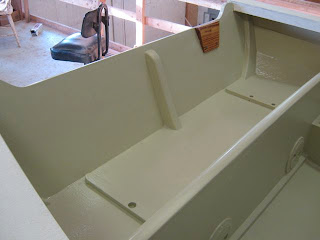This will be the last post about Building BELLE for the year, I hope you're enjoyed reading about my progress (or lack thereof) since last March. I had hoped to have a test-sail in the fall or early winter but will have to settle for an early-Spring launch. Perhaps a frigid late-January test of the hull, just for "fun"! We'll see. In any case, you'll hear about it here, and thank you for your interest in this project.
 |
| After considering various options, I'm using red oak for the coamings. (White oak or really any other hardwood would be fine too, but I like the look of the red oak.) I found nice clear boards pretty easily in the size I needed: 14' long by 7" wide. I planed the boards to 1/2" thick, and here I'm test-bending the first board onto the boat. I made a pattern using scrap 1/8" luan ply for the coamings and carefully recorded various bevels. I'm concerned about the board cracking while I do this dry-fit, so I'm NOT bending all the way to the centerline forward. If I'm feeling lucky, I'll do that next time I work on the boat--2012!--but to be safe I'll probably give the board about 20-30 min in a steam box. That or possibly just pour boiling water over towels wrapped around the board to get somewhat of the same effect. Only the first five feet or so need this treatment since the rest of the board easily follows the bend of the side decks. I'll let you all know how it goes next year! |















